Asus X99-DELUXE U3.1 User Guide - Page 98
External Digi+ Power Control, Enhanced Training CHA/CHB/CHC/CHD [Auto]
 |
View all Asus X99-DELUXE U3.1 manuals
Add to My Manuals
Save this manual to your list of manuals |
Page 98 highlights
Enhanced Training (CHA/CHB/CHC/CHD) [Auto] Configuration options: [Auto] [Enabled] [Disabled] MemTest [Auto] This item allows you to enable or disable the memory testing. Configuration options: [Enabled] [Disabled] Attempt Fast Boot [Auto] This item allows the portion of the memory reference code to be skipped when possible to increase boot speed. Configuration options: [Auto] [Enabled] [Disabled] Attempt Fast Cold Boot [Auto] This item allows the portion of the memory reference code to be skipped when possible to increase boot speed. Configuration options: [Auto] [Enabled] [Disabled] External Digi+ Power Control CPU Input Boot Voltage [Auto] This item allows you to set a higher CPU input boot voltage for better overclocking capability. Use the or to adjust the value. The values range from 0.80 V to 2.7 V with an interval of 10 V. CPU Load-line Calibration [Auto] Load-line is defined by Intel® specification and affects CPU power voltage. The CPU working voltage decreases proportionally to CPU loading. Higher load-line calibration could get higher voltage and good overclocking performance, but increases the CPU and VRM thermal conditions. Select from levels 1 to 9 to adjust the CPU power voltage from 0% to 125%. Configuration options [Auto] [Level 1] - [Level 9] The actual performance boost may vary depending on your CPU specification. DO NOT remove the thermal module. The thermal conditions should be monitored. CPU Current Capability [Auto] This item provides a total power range for CPU overclocking. A higher value setting provides higher power consumption delivery and extends the overclocking frequency range simultaneously. Configuration options: [Auto] [100%] [110%] [120%] [130%] [140%] CPU VRM Switching Frequency [Auto] This item affects the VRM transient response speed and the component thermal production. Select [Manual] to configure a higher frequency for a quicker transient response speed. Configuration options: [Auto] [Manual] Chapter 3 3-24 Chapter 3: BIOS setup















